FRONTRUNNER Introduces Moses Hamborg

Making the leap from a quiet, sheltered life to the mad fascination of an artist’s life is never simple or, very often, broadly supported by those closest to us. A boy from Huntington Beach, California, was home-schooled and told he would best be suited to a career as a lifeguard (he still does it during the summers). He turned down modelling offers and bucked against the expectations of his family to study at the Academy of Fine Arts in Florence. He dove head-first into an artist’s existence and was granted a spot in Kehinde Wiley’s prestigious Black Rock Residency in Dakar, Senegal. All the while, he maintains a studio in Los Angeles.
That was still not enough for Moses Hamborg.
At 26, he is still in search of new experiences and new connections to make with his bristling, vivacious portraits that echo the strokes of giants: Velásquez, Sargent, Whistler, Rubens, and Rembrandt. But his visceral dedication to both subject and craft, with a firm reliance on a fluid, flexible working method sets him apart from his peers. Hamborg was awarded a Certificate of Excellence from the Portrait Society of America in 2019 and exhibited at the BP Portrait Award 2020 hosted by the National Portrait Gallery, London.
FRONTRUNNER introduces a true groundbreaker in the very traditional world of painting and portraiture: Moses Hamborg.
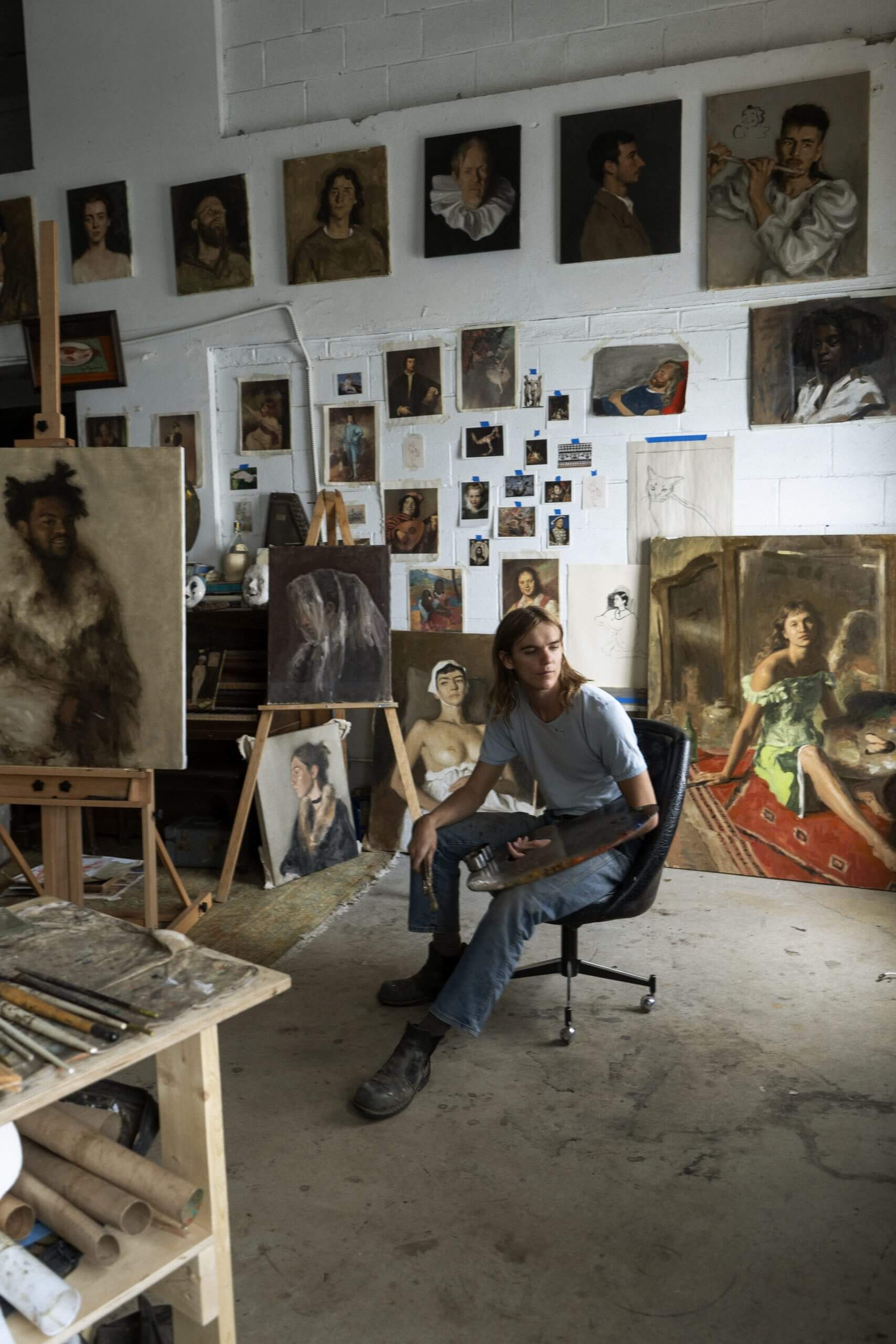
Tell me a bit about yourself. Tell me a bit about your background, and how you discovered painting.
I was born and raised in Huntington Beach [California], in a small house not far from the beach, with four older brothers. I’ve been a lifeguard for nine years, now. I still am a lifeguard and it’s been every summer working on the beach. I grew up drawing, you know, how children grow up drawing; you have this urge to mimic things. In the house I grew up in, there were no paintings on the walls. Just family photos. My dad was a carpenter and firefighter, my mom raised and homeschooled five boys. I was lucky enough to be signed up for some art classes. When you’re younger, you’re never told that being an artist is a viable option for a career. Living in like a suburb-type small city, it felt pretty dry.
After high school, what was the progression like going to study in Florence?
I went to public high school when I was fourteen, for freshman year, and I loved it. I was like, “Oh my God, I get to see all my friends every day!” That lasted for about a week. They tell me where to go, when I need to be there, and how long I should be there. I went to high school and I was like, “I don’t want to be in high school anymore. I know what I want to do, I want to paint. Get me out of here!” So I did independent studies, built up my portfolio, graduated high school early, and got accepted to the Florence Academy of Art. It was funny because my brother and my parents were like, “We think you should stay and become a lifeguard at Huntington City Beach.” I was a lifeguard at State Beach, and they get paid, like, seven cents more, or something like that. It has more of a prestigious reputation. I was like, “Yeah, there are more important things out there than being a lifeguard!” I went out there and it was the best decision I’d ever made.
Living in Florence means that you’re constantly surrounded by the weight of the “masters of the universe”: you see the statues of Dante, Leonardo, Redi. You go inside the Uffizi and every single corridor is historic. It can be overwhelming. Did you feel that intimidation at any point, at the beginning or even throughout?
Living in Florence was definitely a surreal experience. I didn’t even really know what Florence was, didn’t actually understand the impact that Florence had within the Renaissance and within art history. It was really inspiring being able to access that for the first time in person. I definitely put a lot of pressure on myself because it took a lot of work to be able to be there. Of course, it was all self-imposed pressure. I had so much anxiety about being a painter; I was like, “If I’m gonna be a painter, I want to make sure that I’m able to do it well.” This is my education, you know. I took it very seriously. I even turned down some cool opportunities that, looking back, I realised that I could have easily done both!
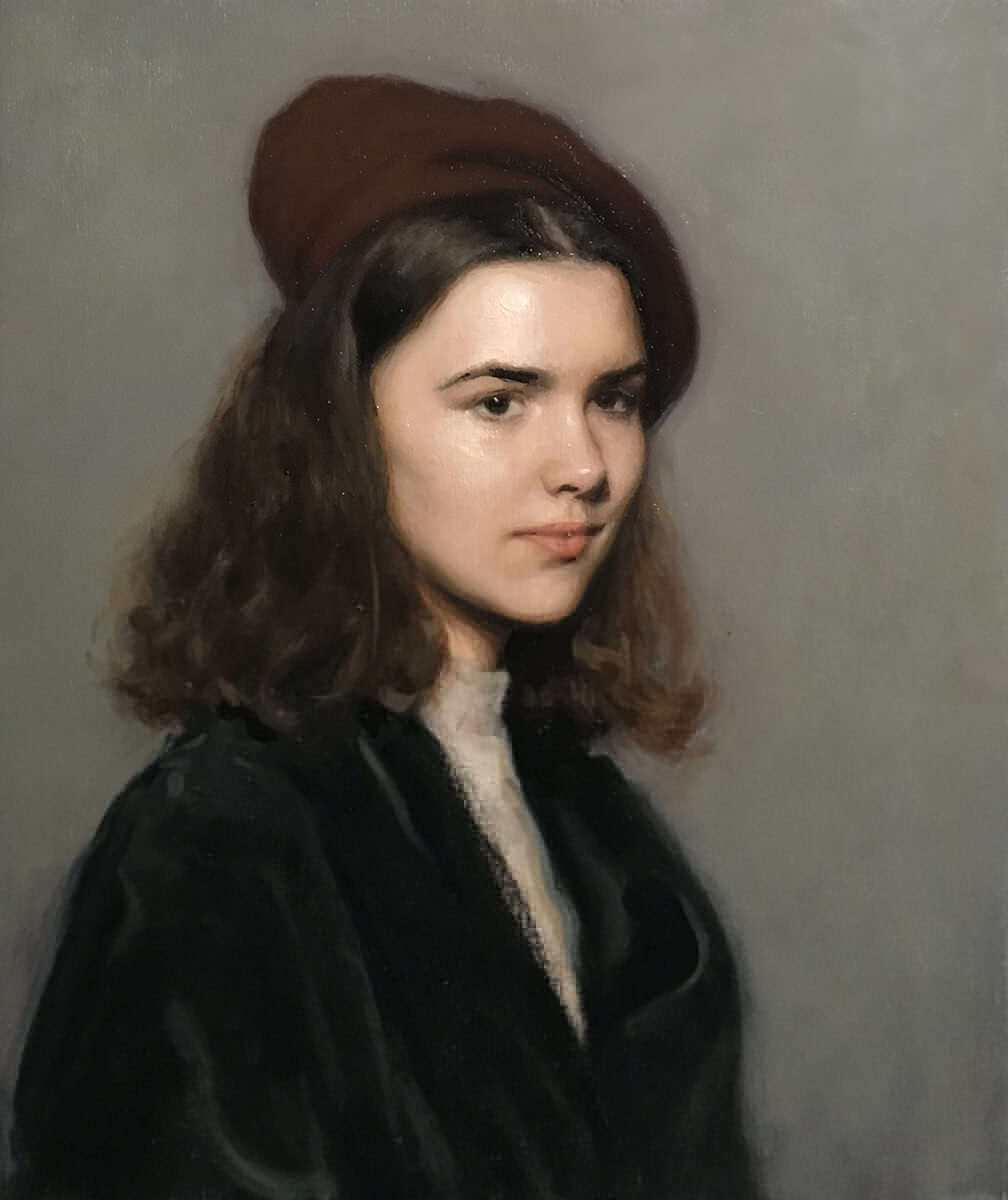
Elle (2019)
50″ x 60″
Oil on canvas
Courtesy of the artist
Like what?
Like Hedi Slimane scouted me when I was in Orange County, at a punk show [back] in Huntington Beach. He was the creative director for Yves Saint Laurent. They had me send them all these photos, and they were going to send me to Paris to walk for Men’s Fashion Week. I was like, “I don’t want to miss class.” I was doing Bargues: these pencil drawings…you spend weeks on the same drawing. I’d get there early in the morning and would draw from life or doing cast drawings until the evening. We’d be studying anatomy and a little bit of art history, but I was literally just drawing all day, every day. Anyways, whatever it got me to – that motivation got me to where I am now. So, I’m not upset about it.
It’s so easy for portraitists to become roped into this vortex of, “Oh you look just like Velázquez, or Goya, or El Greco.” How do you feel about that? Do you appreciate when people say that your work looks like something else, or do you really want to try and move away from that?
The first thing people will say, like, “Oh, Renaissance!” It’s kind of a funny reaction because usually, they sound really surprised. Obviously it’s a huge compliment. Sometimes it feels it’d be easier to be put in a box being a figurative artist and painting in a traditional manner, but for me it’s endless inspiration. Some people reference Sargent, which is obviously super flattering. There’s a direct lineage through Sargent: he studied under Carolus-Duran and worked with William Paxton, who taught [R.H. Ives] Gammell, who taught Charles H. Cecil. I studied with Cecil in Florence. I have massive respect for this longstanding tradition of oil painting, and being able to use this visual language to explore ideas. I’m drawn to humans, I always have been, and sometimes I feel more drawn to humans than I do to painting. There are images, ideas of motifs that I want to be able to execute and explore, but for the most part it’s a pretty natural flow of being inspired by the people I’m surrounded by and trying to capture something about them. Being able to look at someone, observe them and feel something about them, then try and put that onto the canvas is an interesting process. Storytelling has always really interested me. For me, there’s nothing thrilling, and vast and endless than being able to explore the human psyche, you know?
I gather you also paint from photographs or from archival material, as well?
I truly believe it depends on what you’re trying to achieve and what your function is. When I came out of school, I didn’t know what I was gonna do. A friend of mine said, “My dad is retiring, he needs a portrait.” She was a painter too, but she wanted me to do it. The day I graduated, I had my final critique in the morning, got on a bus to Milan and took a RyanAir flight to Belfast. Her dad was the Head of the Public Health department at The Queen’s University. He terrified me.
I remember calling my girlfriend saying, “He’s this bitter old man, I’m so scared of him. I don’t even want to be in the same room as him, and I’m meant to paint him.” I’d never done a portrait commission in my life, and I ended up developing a really nice relationship with this guy and his whole family. They called me their artist-in-residence, and then started sending my portfolio to their friends. So all of a sudden, I just found myself to be this portrait painter and had no intention of it, no plan. But I was really happy to be doing it. Now I don’t necessarily want to be doing portrait commissions if I don’t have to, but I still find myself constantly painting portraits. You look at this Titian painting (I think it’s in the Pitti Palace): this young man and I have probably no connection. He lived centuries ago in Italy, and I’m living in the 21st century from Huntington Beach. But I look at this painting, and not only can I see this person, I can also see Titian. I think that he achieved that from painting him from life; they were sharing this experience together, and I think it truly manifests onto the canvas.
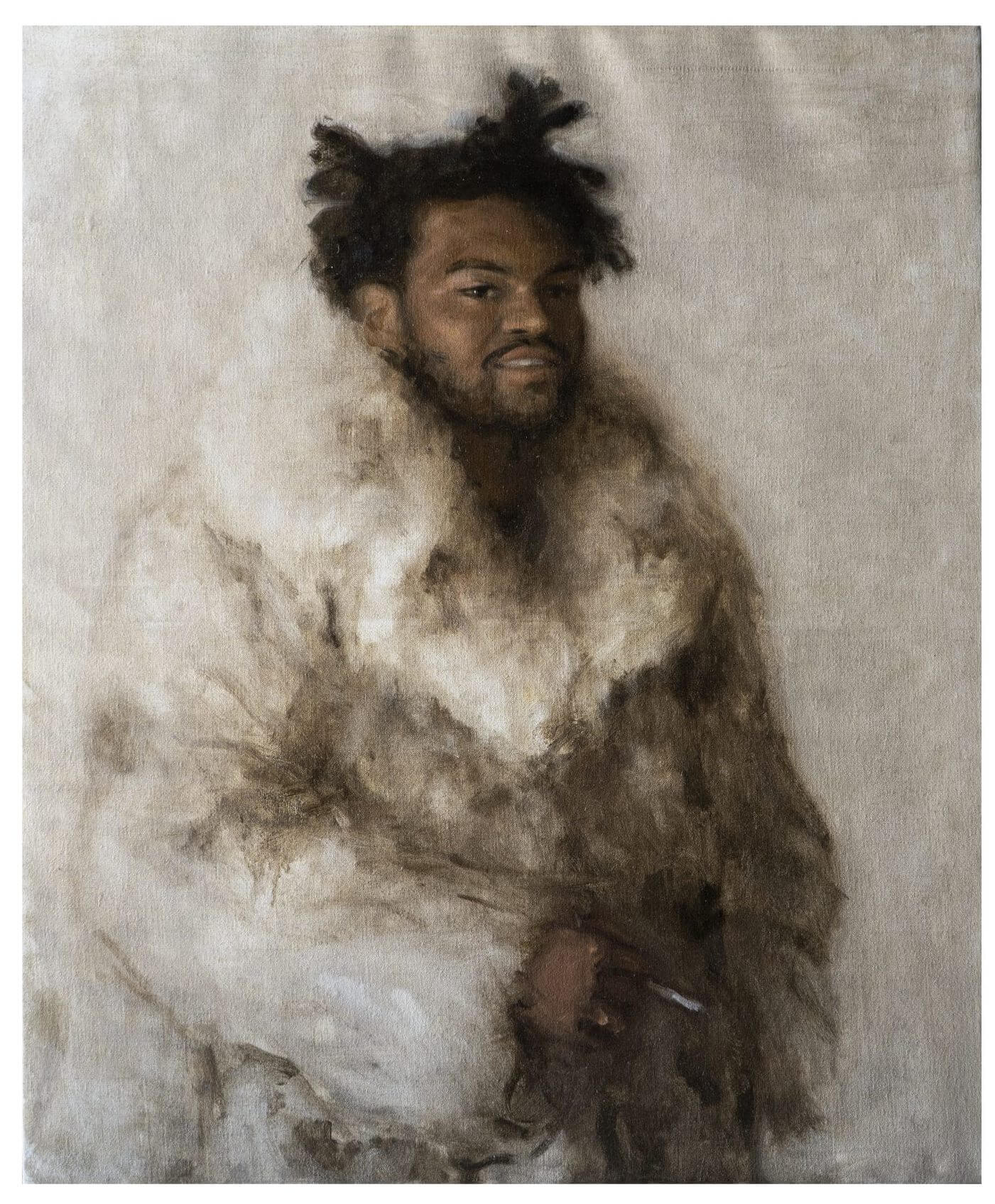
Noah (2021)
35″ x 50″
Oil on canvas
Courtesy of the artist
You were accepted to the Black Rock Residency in Senegal – a major honour. What goals did you set for yourself to move your practice forward while you’re there?
It’s the greatest privilege to just fully throw yourself into your work and to be focused. I recently got a studio in L.A. Even just not having to pick up your own mess, you know what I mean? I’m really looking forward to being in an isolated and focused environment, but also being able to meet new people and be in a new place. I look forward to my process evolving. I’ve been trying to learn more about American abstraction, because I’m all about the Renaissance, European and Russian artists. I’ve been looking more into American artists. You’ve got to build your foundation. I feel like that’s what I’ve been doing. I think it’s gonna be a slow, gradual process. I plan on painting until the day I die, so there’s a lot of time. I don’t want it to be a contrived thing, either.
I discovered your work through Instagram. What are your thoughts about it as a platform: useful? Harmful? Powerful?
I don’t really have a developed opinion about Instagram, but I believe that being inundated with tiny little images all day is certainly not a great thing for viewers or artists. I’ve been reading Eugène Delacroix’s journal, and he talks about being overcome with so many ideas. He says, “If I were to write them all down, put them in a sock and then take them out of the drawer when I have time to execute it, that would be the death of genius.” I have mood boards and save photos on Instagram. I’m an avid Pintrest-er. In terms of it being a platform, I know it has it’s ups and downs ‘cause there’s crazy stuff with the algorithm and how you can get sucked into it. The inspiration should come from within. The most powerful stuff would probably just come from your memory.
There’s a huge amount of pressure and emphasis on originality, you know? There are endless amounts of mediums to use and it’s the classic like millennial thing, what’s the phrase? Master of None? Where you dabble in everything, but then you’re a master of none. As long as we don’t have some contrived sense of originality and are able to look back onto the masters – for me, they’ve achieved so much. I don’t want to be redundant by any means, but I definitely want to pay my dues and learn as much as I possibly can from them. One thing with the introduction of the photograph: we can take these photos, then develop these compositions and ideas through the photo, which is a great tool and a source of reference. But what painters were doing for so long is that they were studying other painters. They would get these etchings of a Rubens and be like, “Oh, look at this etching my friend did when he traveled to Antwerp.” Or, he did a copy of a Rubens and they share it. Then, you’re contributing to the conversation and you’re absorbing what’s been done and, hopefully, adding to it rather than starting from ground zero. I just see it as the history of art and the language of visual art being a conversation. It’s an ongoing conversation and hopefully one that I am contributing to. Respective of the artist of the past, hopefully I am also contributing to it, as well.
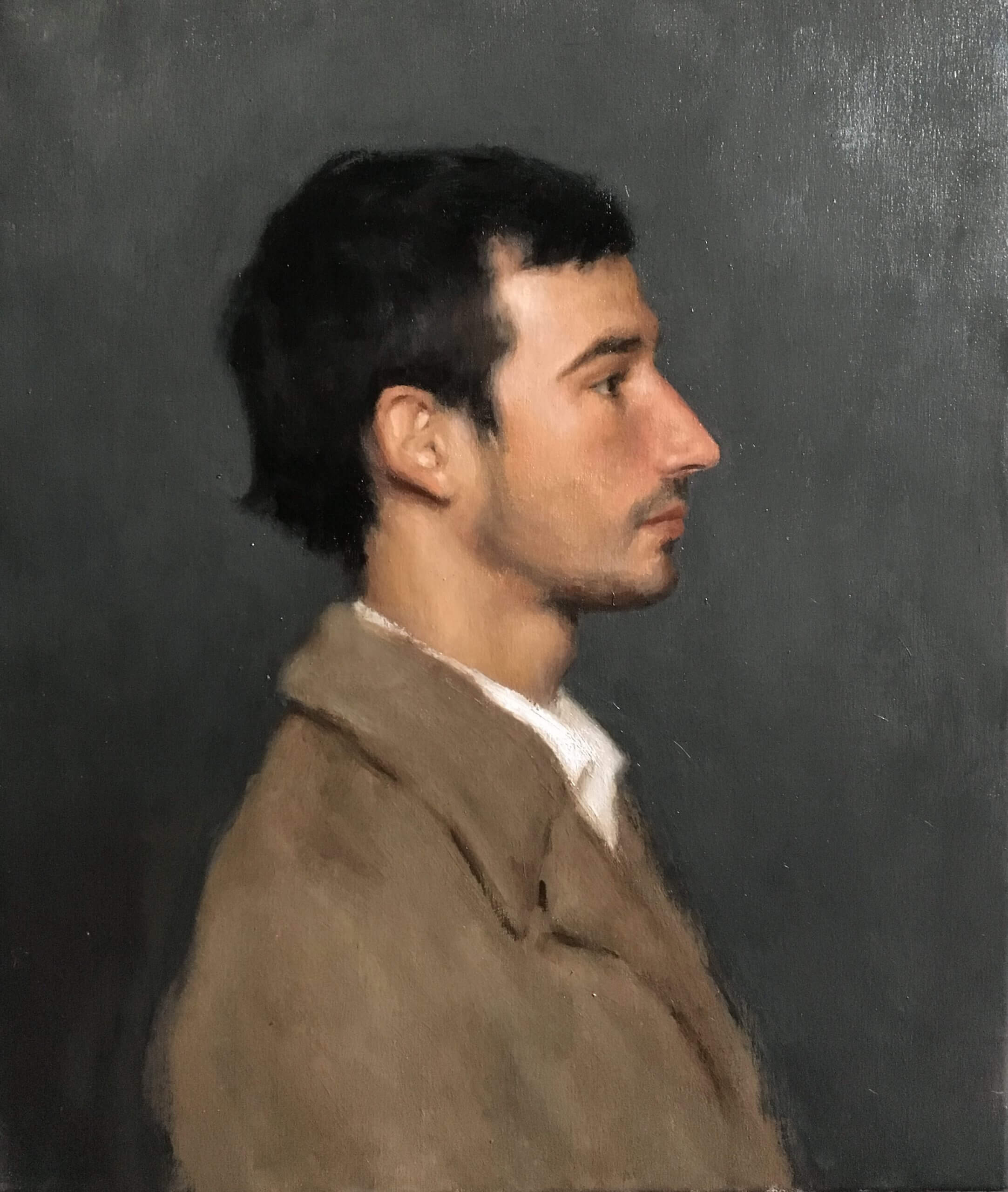
Francesco (2018)
50″ x 60″
Oil on canvas
Courtesy of the artist
The “holy trinity” of portrait artists. Who are they?
Oh God, it’s always ebbing and flowing. I love El Greco. Velázquez is everything for me. I was able to go to the Prado a couple years ago. My flight got cancelled and I was stuck in Madrid for like, six days. I went, I think, every single day for like six days in a row. So Velázquez, he’s my guy, and Titian, Sargent. Sofonisba Anguissola was this Italian portrait painter; Van Dyck did this really sweet portrait of her. Artemisia Gentilleschi…
Ugh, what a hero.
Yeah, love her.
Last fun question: is there anything in your studio that you can’t go without? Even if it’s not technical; something in your studio that you always have to have?
Um, no! I literally go to people’s houses and paint them. I just bring my backpack with me. Whenever I start a painting I start it completely differently. I don’t have a set-in-stone method or process, I just work quite visually. I like Old Holland paints because they are much more expensive, they will last way longer ‘cause the pigmentation’s so much stronger. Then your paintings look better, so whatever you can do to make your paintings look better, it’s usually worth it in the long run. I try to mix my own paints, when I have the time.







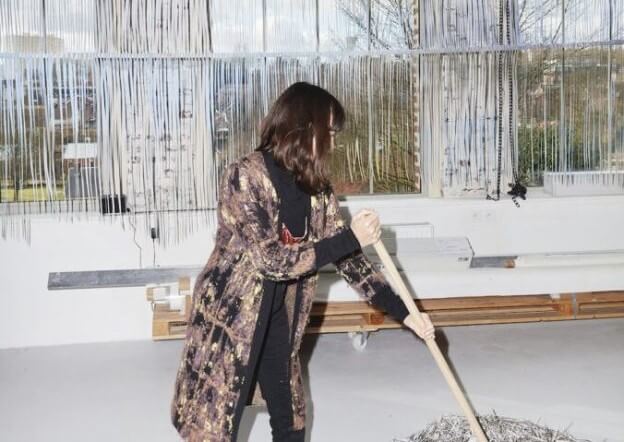

Responses